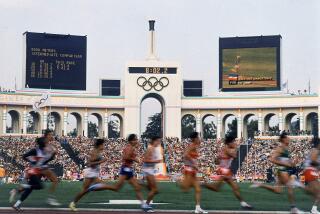THE GREATEST DAY IN TRACK & FIELD : 50 Years Ago, Jesse Owens Had an Afternoon Like No One Else
Fifty years ago today, a 21-year-old sophomore from Ohio State University turned in perhaps the greatest performance by any athlete in history.
May 25, 1935, was a sunny, hot afternoon in Ann Arbor, Mich., a day that ended a week of cloudy, overcast skies. Within an hour that day, Jesse Owens, in the season before he dominated the Berlin Olympics, established himself as the greatest sprinter, hurdler and long jumper in the world.
It was the Western Conference--itâs known as the Big Ten now--meet, at Ferry Field. Those still living who attended that day still talk about it.
Hereâs what Owens did:
3:15 p.m.--Ran 100 yards in 9.4 seconds, tying the world record.
3:25 p.m.--Long jumped once and broke the world record of 26 feet 2 1/8 inches with a leap of 26-8.
3:35 p.m.--Ran the 220 in 20.3, breaking a world mark of 20.6 that had stood for nine years.
4 p.m.--Ran the 220-yard low hurdles in 22.6, breaking the world mark of 23.0, set in 1924.
Thatâs three world records and a fourth tied in 45 minutes. And had it not been for a quirk of fate before the 100, he would have gone four-for-four.
In the 100, according to Track & Field News, there were six timers--three official and three alternates. The watches read, in order: 9.4, 9.4, 9.4, 9.3, 9.3, 9.3. If, before the race, two of the alternates had been designated official timers, Owens would have been credited with the worldâs first 9.3.
His long jump record lasted a quarter of a century, until Ralph Boston jumped 26-11 in 1960. When Owens jumped 26-8 that day, only about 10 men had ever jumped 25 feet.
Attendance that afternoon at the University of Michigan was about 5,000, and among the spectators was a 17-year-old high school football prospect from Gary, Ind., who was being heavily recruited by Michigan. His name? Tom Harmon.
âThere was tremendous excitement,â said Harmon, who went on to football glory with the Wolverines. âIt seemed like each race theyâd announce âWorld record!â âWorld record!â Geez, there was a tremendous excitement.
âIt was a long time ago. But if you ever saw him run, one thing you never forgot about Owens is how fluid he was. He seemed to run just to the point of winning, he never seemed to have to shift into high gear. Three world records was one thing, but to do it as easily as he seemed to be running, that made it all the more amazing.
âIt was quite a day. And it sure gave me a lot to talk about when I got back to Gary.â
Another who remembers is Mel Walker, Owensâ Ohio State teammate who finished third in the high jump that day with a leap of 6-2 5/8. Walker, 71, lives in Chicago.
âOne thing I remember is how big the crowd was,â he said. âJesse was the only track athlete in those days who could fill a field house or a small stadium by himself. And he had a way of making everything stand still when he competed. When he ran in a race, every person in the stadium--every athlete, coach, official and spectator--would freeze and watch him.
âThe 220 was the most exciting record that day. There was a big crowd, and it was a long race, so everyone got a good look at it. And when the P.A. man announced that it was a world record (20.3) and that the old record was 20.6, well . . . everyone got pretty excited.
âJesse was a picture runner, you know. He just looked so good when he ran.
âWhen he broke the long jump record on his first and only jump, that wasnât unusual. In all meets we competed in, he almost never took more than one jump. The only exception I can think of is the Olympics, when he had so much trouble getting his steps down.
âI kidded Jesse over the years about that day at Michigan. He was suffering from back spasms the night before, and I gave him a long rubdown the night before. I always told him: âIf it hadnât been for my rubdown, you never wouldâve been able to walk on the track that day.â â
A half-dozen Midwestern newspapermen covered the meet, along with one Associated Press reporter. His report was top-of-the-page news in most U.S. sports sections the next morning, even though another giant of sports had turned in a memorable performance the same day.
While Owens was rewriting the record book in Ann Arbor, Babe Ruth had something of a swan song in Pittsburgh. Playing for the Boston Braves in his final summer of baseball, Ruth hit the last home runs of his career, Nos. 712, 713 and 714 at Forbes Field. Several games later, he retired.
Nevertheless, Ruth took a back seat in at least two papers the next morning. In the Los Angeles Times, it was âOwens Breaks Three World Recordsâ across the top of the sports section. A photo of Owens in mid-flight was overlined: âHereâs Greatest Leap Ever Made by Civilized Man.â
At the fold, a one column headline read:
âHomer Orgy
by Bambinoâ
In the New York Times, Owensâ day of days was the No. 4 story, behind crew and horse races, and a golf tournament. Ruth was the No. 11 story on Page 1, at the bottom of the page.
Today, itâs a curiosity that two of the biggest names in 20th Century American sports would have two of their most memorable days on the same day, particularly since Ruth had an unusually long competitive career and Owensâ was relatively brief. Ruth spent 22 years in the public eye, but Owens was a shooting star who competed on the world scene for little more than one calendar year, in 1935 and â36.
He had gained some national attention as a high school track phenomenon at Clevelandâs East Tech High in the early 1930s. As a prep, he ran a 9.4-second 100, equaling the world record.
Three weekends after his day of days in Ann Arbor, when Ohio State met USC in a dual meet at the Los Angeles Memorial Coliseum, Owensâ presence attracted 40,000. Owens won the 100 in 9.7, the long jump in 25-5 1/2, the 220 in 20.7 and the 220 low hurdles in 23.1.
In the first nine days of August, 1936, he was showcased to the world, at the Berlin Olympics. Under the anguished gaze of the Nazi hierarchy, he won the long jump at 26-5 5/16, the 100 meters in 10.3, the 200 in 20.7 and ran the leadoff leg on the winning U.S. 400-meter relay team.
Then, in a twinkling, it was over.
Owens got into a beef with U.S. Olympic Committee officials after the Olympics. Without consulting him, they booked him into post-Olympic track meets throughout Europe. All he wanted to do was go home to Columbus, to his wife, Ruth.
Thatâs exactly what he did, despite threats of banishment.
The USOC and the Amateur Athletic Union suspended Owens. At 22, he was through. Four gold medals and out.
His campus job, which supplemented his meager scholarship, was running a freight elevator from 4 p.m. to midnight. He made some fast money at personal appearances, but when the luster faded, he had to earn money by performing degrading stunts, such as racing horses and dogs at county fairs. He ran against baseball players at ball games.
He formed a touring basketball team. He formed a dance orchestra. He was a Cleveland playground director. He started a dry cleaning shop in Cleveland, but went broke.
Harmon, who became a friend of Owens in later years, recalled Owensâ difficult post-competition years:
âI told him a long time ago how sorry I was to see him having to race horses, that his having to do that for a living was the crime of the century.
âJesse said to me: âHey, I hated it, too. But I had no choice. I had a family to feed.â â
Owens, the son of an Alabama sharecropper, died of lung cancer in 1980. He was 66.
In his later years, he became a polished speaker and something of an unofficial Olympic ambassador to the world. He traveled widely. Until a few weeks before he died, he spoke out against the United States boycott of the 1980 Moscow Olympics.
When he died, for most who remembered him, Owens was the Olympics. But for the relatively few who remembered May 25, 1935, Jesse Owens represented excellence, a rare moment when a great athlete, for one day, reached out and touched perfection.
MAY 25, 1935 AT ANN ARBOR, MICH.
100 Yards 9.4 Tied world record 220 Yards 20.3 Broke world record of 20.6 220-Yard 22.6 Broke world record of 23.0 Low Hurdles Long Jump 26-8 Broke world record of 26-2 1/2
More to Read
Go beyond the scoreboard
Get the latest on L.A.'s teams in the daily Sports Report newsletter.
You may occasionally receive promotional content from the Los Angeles Times.










